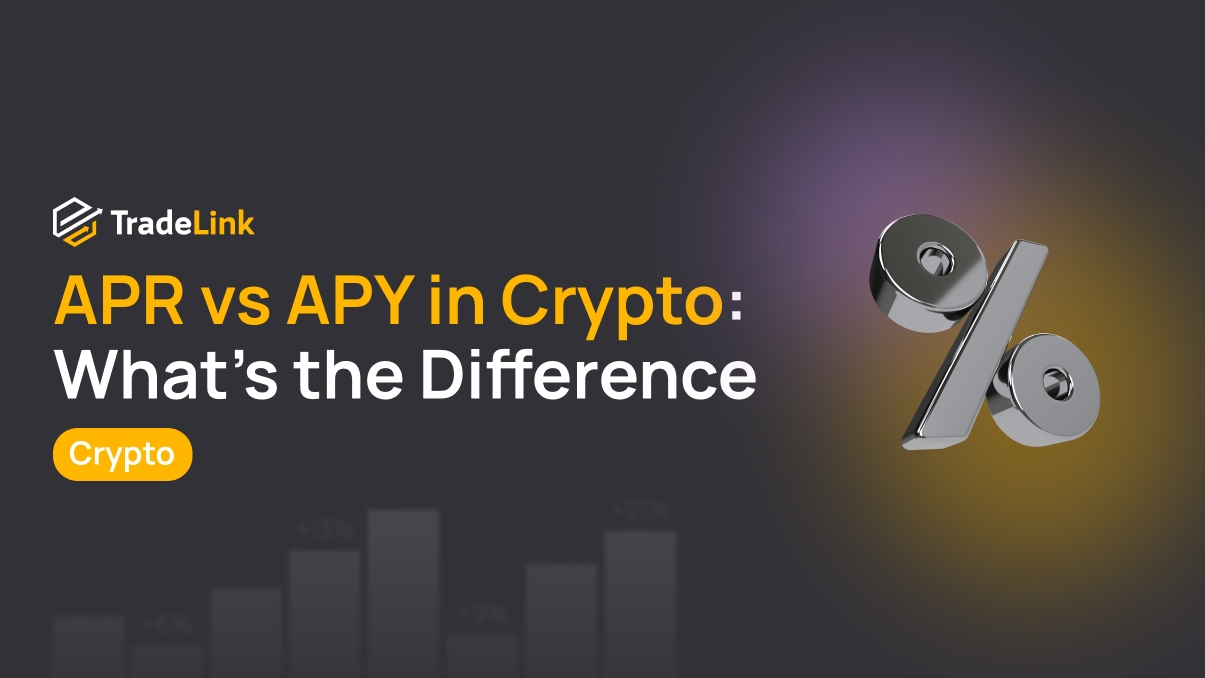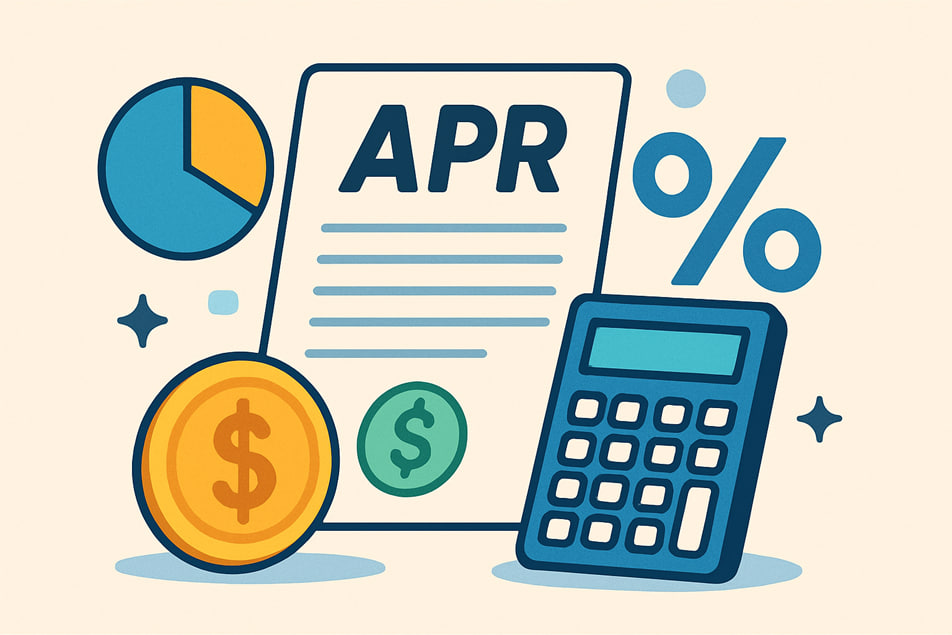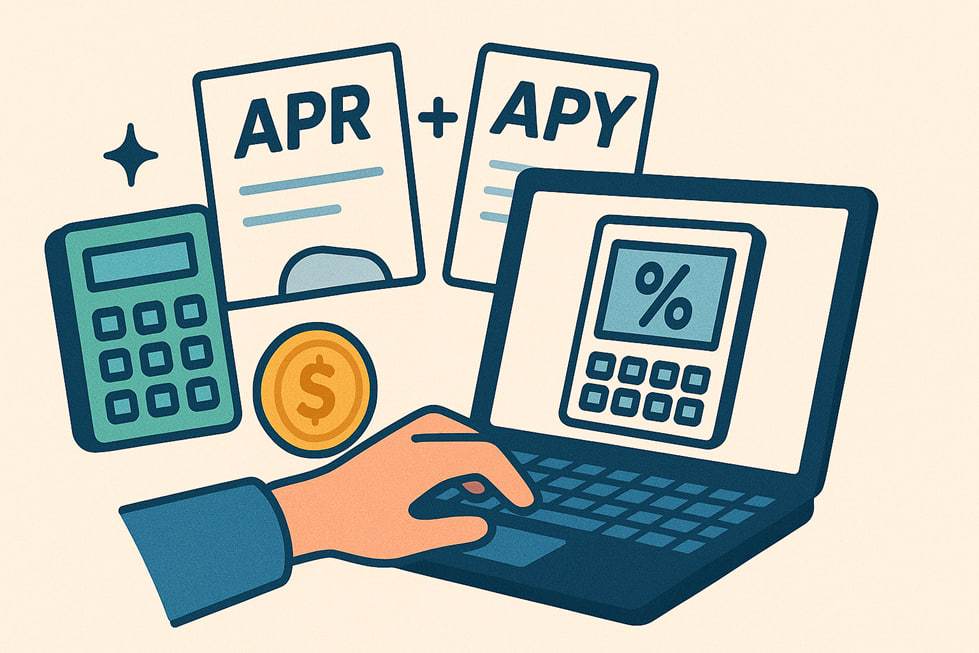APR vs APY in Crypto: What’s the Difference and How to Calculate Returns

Contents
- Introduction
- What Is APR
- What Is APY
- Key Differences Between APR and APY
- How to Calculate APR and APY
- Practical Examples
- Conclusion
Introduction
Regarding returns in finance or cryptocurrencies, two indicators are often mentioned — APR and APY. They may seem similar, but they mean different things. One shows the interest rate without compounding, the other shows the interest rate with compounding considered. These differences are significant when assessing profit, especially for long-term investments.
In this article, we’ll explain APR and APY, how they differ, where and how they are used, and how to calculate returns correctly based on them.
What Is APR

Definition of Annual Percentage Rate
APR (Annual Percentage Rate) is the annual interest rate that shows how much you will earn or pay in a year if interest is not added to the principal. This is a simple interest rate that does not consider reinvestment of earned interest.
For example, if you invest $1,000 at an APR of 10%, you will receive $100 after one year. Even if interest is paid monthly, the total will still be $1,100 because APR doesn’t account for interest compounding within the year.
Where APR Is Used
APR is most often used in situations where there is no automatic reinvestment:
-
Loans and credit. Banks and microfinance institutions display APR as the main loan rate.
-
Staking without compounding. Some cryptocurrency platforms offer fixed returns without reinvestment, and in such cases, APR is shown.
-
Returns without capitalization. APR provides an accurate income picture if an investor withdraws their profit immediately rather than leaving it in the account.
APR is convenient if you plan to make regular profits and don’t want to deal with complex formulas. But if profits remain in the account and continue to generate income, APR will not show real profitability — for that, APY is more suitable.
What Is APY

Definition of Annual Percentage Yield
APY (Annual Percentage Yield) indicates how much you can earn in a year if the interest is regularly added to the initial amount. It considers compound interest, which is calculated not only on the initial deposit but also on the previously earned profit.
APY is higher than APR for the same interest rate because the interest grows yearly. This metric helps better understand how much you’ll end up with if you don’t withdraw your profit.
How Compound Interest Works
Compound interest works on a simple principle: each time profit is earned, it is added to your balance. Next time, interest is calculated on the new, larger amount.
For example:
-
Initial amount — $1,000
-
Interest — 10% per annum
-
Interest is paid monthly
After the first month, ~$8.33 is added to the balance, so next month’s interest will be calculated at $1,008.33. The more frequent the interest payments, the faster the total grows—this is capitalization.
This approach is fundamental if the user does not withdraw profits and keeps the asset staked or in a deposit account.
Key Differences Between APR and APY
To better understand the difference between these two indicators, consider the following example:
Parameter | APR (no compounding) | APY (with monthly compounding) |
Interest Rate | 10% | 10% |
Initial Deposit | $1,000 | $1,000 |
Result After One Year | $1,100 | $1,104.71 |
As we can see, APY provides higher returns even with the same rate. That’s because the profit earns profit. This difference can be significant, especially for long-term investments.
Approaches to Assessing Profitability
APR and APY are suited to different tasks:
-
APR is convenient if you regularly withdraw profits or work with a fixed rate without compounding. It shows straightforward income without extra calculations.
-
APY is useful when you reinvest your earned profit. It shows real returns taking into account balance growth throughout the year.
The choice between these two indicators depends on your strategy. If you want to maximize profit through holding and compounding, focus on APY. APR is a better fit if your approach is closer to short-term investments.
How to Calculate APR and APY

APR Calculation Formula
APR (Annual Percentage Rate) shows the percentage of annual income without reinvesting profits. The calculation is straightforward:
APR formula: Income / Initial Amount × 100%
Example:
You invest $1,000 in staking with an annual return of 12%. After a year, you receive $120 profit.
APR = 120 / 1000 × 100% = **12%
**APR shows the annual return percentage if profits are not reinvested.
APY Calculation Formula
APY (Annual Percentage Yield) is the effective annual rate for regular compounding. If profits are added several times a year, the total income increases.
APY formula: (1 + r / n)ⁿ − 1
Where:
-
r = annual interest rate in decimal form (e.g. 0.10 for 10%)
-
n = number of compounding periods per year (in our example, 5)
Example:
Interest rate is 10% annually, compounding occurs 5 times per year:
APY = (1 + 0.10 / 5)⁵ − 1
APY = (1 + 0.02)⁵ − 1
APY ≈ 1.10408 − 1 = 0.10408, or 10.41%
At the same 10% annual rate, APY reflects a more accurate yield if profits are kept in the account and continue earning returns.
Practical Examples
Comparison Using Crypto Platforms
Different platforms offer different crypto-earning terms — some use APR, others APY. This can significantly impact total returns, especially if compound interest and frequent payouts are involved. Below is a comparison table with examples showing how both indicators work in real conditions.
Platform | Type of Yield | Rate | Payout Frequency |
Binance (Simple Earn) | APR | ~5% | Profit must be claimed manually |
Binance (Locked Staking) | APY | Up to ~14% | Interest is auto-reinvested |
Crypto.com | APY | Up to ~19% | Weekly compounding |
Coinbase (SOL staking) | APY | ~5.4% | Capitalization happens automatically |
Platforms offer different yield options based on conditions: some have higher rates but require locking funds, while others offer lower returns with quicker withdrawals. These tools suit moderate strategies to preserve assets and earn modest income.
However, those looking for more efficient capital growth strategies are interested in dynamic approaches. For example, in 2024, the Benchmark Index showed a 63% increase.
This was achieved through flexible asset allocation and continuous risk reassessment. Such results are difficult to accomplish on platforms with fixed income, so more users are turning to advanced strategies.
Choosing the Right Indicator
APR and APY serve different purposes. If you plan to hold an asset and manually withdraw profit, it’s better to focus on APR—it shows how much you can earn without compounding. This approach is helpful for short-term investments and easy platform comparisons.
APY reflects income with regular reinvestment. It’s valuable for long-term strategies where profit stays in the system and continues to grow. It accurately represents real returns in DeFi and staking platforms.
If you’re just starting, start with APR. If you want to benefit more from compounding, consider APY. In any case, always evaluate not just the rate, but also the terms: fund lockups, risks, and platform stability.
Conclusion
APR and APY are key indicators that help assess profitability in cryptocurrencies and other financial tools.
APR shows what you earn without reinvesting. APY reflects income with compound interest.
The difference between them can be significant, especially with frequent compounding.
The choice between these two metrics depends on your strategy. APR is suitable if you want a simple calculation. If you’re ready to leave your profits in the system for maximum effect, go with APY.
Understanding the difference between these indicators and how to apply them in practice is essential. This will help you make better decisions, compare offers, and choose tools that best match your goals and expectations.